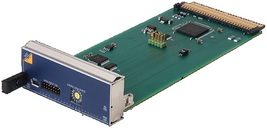
N.A.T. announced the NAT-JSM, an easy-to-use to use JTAG programming device for MTCA systems that allows an easy access to devices which can be programmed via JTAG such as FPGAs. The NAT-JSM is a flexible testing and diagnostic JTAG Switch Module to accelerate the design, prototyping and operation of your MicroTCA (MTCA) embedded computing system.
It provides JTAG vector testing of all slots in a system using just one module. By default, the NAT-JSM automatically arbitrates the JTAG master port, the slave port is selected by the TAP controller (default) or by a rotary switch or web interface. You can configure the NAT-JSM manually using the onboard FPGA through the front panel or the NAT-MCH to suit almost any existing JSM system connector, as long as it is based on the AMC connector layout. The module can detect whether it has been inserted into an AMC, MCH or JSM slot and only turns on its output drivers if it detects a JSM slot.
The key features in a nut shell:
“This new JTAG switch module provides engineers and system integrators with a very easy-to-use tool to test and program JTAG devices during development, testing and deployment,” said Heiko Körte, Vice President and Director of Sales and Marketing at N.A.T. GmbH. “N.A.T. can also adapt the NAT-JSM to meet any pin-out of the JTAG backplane connector as long as it follows the requirements for an AMC connector.”
The NAT-JSM seamlessly works with the XILINX development suits Vivado and ISE and N.A.T. continues to extend the support for other design suits of other vendors. User's of design suits which are currently not supported for seamless operation over Ethernet can always connect to the JTAG interface through the USB or header connectors at the front panel of the NAT-JSM.
More information.
It provides JTAG vector testing of all slots in a system using just one module. By default, the NAT-JSM automatically arbitrates the JTAG master port, the slave port is selected by the TAP controller (default) or by a rotary switch or web interface. You can configure the NAT-JSM manually using the onboard FPGA through the front panel or the NAT-MCH to suit almost any existing JSM system connector, as long as it is based on the AMC connector layout. The module can detect whether it has been inserted into an AMC, MCH or JSM slot and only turns on its output drivers if it detects a JSM slot.
The key features in a nut shell:
- JTAG download via MCH through Ethernet
- JTAG programming connector at front panel
- Automatic arbitration between JTAG Masters
- Target selection through JTAG information
- Overrule of automatic operation and dedicated selection of JTAG target by front panel elements
- Multiple JSM pinout configurations via FPGA
“This new JTAG switch module provides engineers and system integrators with a very easy-to-use tool to test and program JTAG devices during development, testing and deployment,” said Heiko Körte, Vice President and Director of Sales and Marketing at N.A.T. GmbH. “N.A.T. can also adapt the NAT-JSM to meet any pin-out of the JTAG backplane connector as long as it follows the requirements for an AMC connector.”
The NAT-JSM seamlessly works with the XILINX development suits Vivado and ISE and N.A.T. continues to extend the support for other design suits of other vendors. User's of design suits which are currently not supported for seamless operation over Ethernet can always connect to the JTAG interface through the USB or header connectors at the front panel of the NAT-JSM.
More information.
